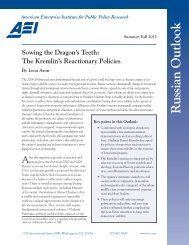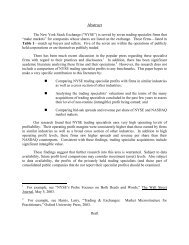Download the PDF - American Enterprise Institute
Download the PDF - American Enterprise Institute
Download the PDF - American Enterprise Institute
Create successful ePaper yourself
Turn your PDF publications into a flip-book with our unique Google optimized e-Paper software.
8 SLAVERY AND THE CONSTITUTIONAL CONVENTION<br />
tion. But when we today—and this includes historians—think back<br />
to <strong>the</strong> problem of slavery at <strong>the</strong> Convention, we too often think of<br />
it as if that history that subsequently unfolded was <strong>the</strong> history <strong>the</strong>y<br />
foresaw, expected, or experienced—but it wasn’t.<br />
Paradoxically perhaps, achieving clarity on <strong>the</strong> history that<br />
occurred after <strong>the</strong> adoption of <strong>the</strong> Constitution is most important<br />
for accurately understanding our topic. The posthistory—<strong>the</strong> history<br />
after <strong>the</strong> Constitution was made—involved a real transformation<br />
of <strong>the</strong> slavery system. In <strong>the</strong> period around <strong>the</strong> time of <strong>the</strong><br />
Constitutional Convention, <strong>the</strong> main use of slave labor in America<br />
was to produce tobacco in <strong>the</strong> upper South and rice and indigo in<br />
<strong>the</strong> lower South. But starting in <strong>the</strong> 1790s, <strong>the</strong> Sou<strong>the</strong>rn economy<br />
shifted to cotton. And <strong>the</strong> shift to cotton was fueled by two technological<br />
developments.<br />
First was <strong>the</strong> development of steam-powered machinery, which<br />
led to <strong>the</strong> development of <strong>the</strong> textile industry in Britain, which led<br />
to <strong>the</strong> production of cheaper cotton cloth, which led, in turn, to a<br />
rising demand for raw cotton. The second big technological breakthrough<br />
was <strong>the</strong> famous cotton gin. The cotton gin was particularly<br />
important in driving <strong>the</strong> transformation of <strong>the</strong> Sou<strong>the</strong>rn economy<br />
because <strong>the</strong> kind of cotton that could be grown readily in <strong>the</strong> <strong>American</strong><br />
South was a kind in which <strong>the</strong> fibers of cotton and <strong>the</strong> seeds of<br />
<strong>the</strong> cotton were very difficult to separate. The cotton gin made it<br />
possible to do this separation cheaply and relatively easily. With <strong>the</strong><br />
cotton gin, cotton became an economically viable crop for <strong>the</strong><br />
South, and with <strong>the</strong> ever-increasing demand for raw cotton, it<br />
became an economically lucrative crop.<br />
The difference cotton production made after <strong>the</strong> Constitutional<br />
Convention is readily visible in a few simple statistics. In 1790,<br />
roughly at <strong>the</strong> time of <strong>the</strong> Convention, <strong>the</strong> United States produced<br />
3,000 bales of cotton. In 20 years, that figure increased six-fold, and<br />
by 1858, near <strong>the</strong> start of <strong>the</strong> Civil War, cotton production stood at<br />
four million bales—from three thousand to four million, more than<br />
a thousand-fold increase. Cotton became <strong>the</strong> leading <strong>American</strong><br />
export, and <strong>the</strong> dollar value of cotton was greater than that of all<br />
o<strong>the</strong>r <strong>American</strong> exports combined.






